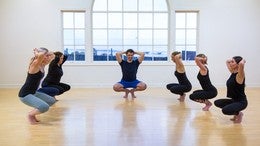Description
This tutorial is a continuation of Juan's Lower Extremities workshop. You can also watch his assessment to learn what you can do help avoid or help common injuries.
About This Video
Transcript
Read Full Transcript
Uh, hello. Uh, this is one NATO again, uh, with Juliana who is helping us today. Uh, we're going to work a little bit about lower extremities and about the control and conditioning and strength and trying to understand why, uh, lower extremities injuries happen and, and what to do about it. So first thing we're going to do is a little assessment and then we're going to use the different equipment like, uh, especially the chair that I really like to do, uh, to use it a lot for, for these kinds of exercises. Um, and then the trapeze table and a reformer and some exercise on their, on their mud, uh, just to explore the, the equipment and the exercise that we already know. Many people ask me, what can I do? What exercise can I do to improve, um, lower extremities and my alignment and my control? I miss that. My stability and I always tell the same, we have amazing exercises in the plotters repertoire. We just maybe need to understand it in a, in a better way and to tweak it a little bit. So, so it will serve our, our purpose in, uh, in, in a better way. So, so let's, let's start with a little assessment. So it's not like a test or a screening or something that you get any score, you know, it's just to have a reference just to have a sense of how your body moves and, and how can we change it or how can we make it better after, after the exercise.
So, so we said before and after kind of situation. So the first thing we are going to do is a, a full squat. Okay. Not overhead just to see and to focus on the lower extremities. But what we are going to do is to use the boombox because I'm very interested in see how you perform the full squat pattern in a, in a very polo field position. Um, this is gonna create a very interesting pattern in the hips. So it's gonna, uh, force your body to work into a relative internal rotation, which is interesting to, to, to create a range of motion and also is going to ask your feet to engage and to work in a, in a very stable way. So let's, we're going to start with this. Okay. So Mumbox that you all have in your studios, if it's too slippery, you can turn around, which is usually, uh, how I, how I do it. So put your feet. Yeah.
So we're going to take the Malleolus out of the, out of the box so you have a little bit more room. Okay. And trying to keep the feet completely on the floor. Uh, try to get connection from the inner part of the fruit against the Mumbox. Um, go in a full squat. Yeah, that's it. Okay. It's not as easy as it looks. Right. Okay. All right. So what we can see is how your food are working, how your balance is. Um, and with the news ones wants to do. Okay.
Can you go up? Would you have like a coffee in that position? You're not very comfortable. Okay. So that's one of the things that I want to check is how easy is this position for you? And at this moment is not the easiest position, but, but, but it's, it's okay. You can, you can do it. All right. That's it. So we're gonna keep it that way. Okay. So the second thing I want to check, which is kind of important for me is how can you create motion in a standing standing leg in a stands led into a hard squat pattern. Okay. So the idea is that you go into one leg, try to keep your body as ab rate as you can. Alright.
And then lower your center of gravity, keeping yourself vertical and go up. Okay. So one of the things that I want to measure is how much movement do we have in the angle? So, uh, how much is necessary, at least over the longest show would be interesting. Okay. So to see definitely has the range. She's definitely kind of upright. So we can go up. And another thing that I'm interested, if you, if you want to change the legs, you can do it. Okay. It's what happens with the knee. Okay?
So if the knee needs to move too far away into internal rotation or external rotation. So we're going to check too. So one of the thing is your ability to be [inaudible]. The second thing would be the ability of your ankle to move forward. And the third, and the third thing is how you create that movement. Okay. So in this leg it looks like, uh, the movement is a little bit more limited.
Okay. And the tendency of your buddies to go internally. So this gives me like a lot of information to, to, to work on that. If it's too challenging and they cannot do it, maybe you can just have a little support. We take away all this, uh, stability issues and then we can focus on the mobility and, and, and the truck in the specific truck and into the, into the hips. So what is really important for me, it's that we are not looking at very kind of sagittal movement, like a one dimensional movement because that doesn't really exist.
So, so if you feel that when you're running or when you're working, the body is completely moving in the sagittal plane, you really are wrong. So, so the knees completely changing all the time and the movement is three dimensional. So, so what you really want to see in this kind of motion, it's not like they go all the way forward, but if there's a little challenging adjustment, the adjustment is accurate, is fast, that the client knows how to do it. So, so do not look for the perfect movement but kind of control movement. And that doesn't necessarily mean that is in the sagittal plane, could be little bit internal or a little bit external, but it's some sort of control and communication between the tissues and, and, and that the person, okay. So that would be the second thing that I would look at. The third thing is, uh, just check what happens in the hip. Okay. So many people complain about the, about the knees and they have knee issues and the knee is a very complex joint and, and the poor knee suffers all the, the, the problems from the hip. And, and from the food. So if we want to give some relief and some support to the knee, what we have to do is to work on the hip basically on the foot and another way out. But specifically it's important to see how the hip and the and the food are doing. So that's why the first, uh, tests are giving us information. The first day the squad is giving us information about the hip and also the food. The second one is it's basically about the heap and the food.
And both are in close chain. So, so we're using gravity and we're driving the movement against the floor, which is a, usually what happens in standing and activities. So what we want to see now is how you can create motion in a open chain situation from the hip and also how your body stabilize that. Okay? So if you can face me now, what I want you to do is try and just to bend your knee as much as you can. Okay. That's it. So ideally, uh, I, a good extension pattern will cross the midline. So that's kind of the reference that you want to use. Um, and you want to do that without creating a lot of extension through the lumbars.
Okay. So let's see the other one. Good. Could you go any farther? That's it. It's a tiny bit more. Okay. I need it looks stable. Um, so even though we use a knee flection here a while, we really challenging is the hip extension. So we are kind of engaging the hip extensors and also the stability of the, of the trunk to make sure that we can create a movement, uh, from, from the knee. But the challenging part here is, is, is, uh, is the hip. So we are challenging the hip at the end range of Eh hip extension because once you get here, you are at the end range of hip extension and then you challenging trying to create a little bit more room there with your muscles using the inner range of the, of the muscles. The same idea would be just the next, uh, exercise, which is just, uh, their leg extended. Sorry.
Uh, go as high as you can with your knees. Okay.
So we're going to focus on extending the stance leg quite a lot and do it again. Okay. So less focus on the stance leg. Very, very extended. Good job. Great. It's a bit different, right? And it's also, we are also engaged more movement from a more activity from the hip flexors. Good job. Okay. So again, in those tests you don't want to see like a specific degrees or something.
But if you are working with somebody and this is the range of motion and this is the range of motion, you know that definitely something is wrong. So it's gonna drive your decision making process into that particular part of, of the workout instead of the mobility or something else. But you really need to understand what to do with them. In order to get there the most from, from, from them. Okay. Are we cool? So the next exercise is, uh, again into the ankle. Uh, now we're gonna work on pure mobility so we can use a reformer, which has a very nice stable, uh, good height to do it.
So very, very easy test or exercises. Just put the food over the platform, make sure that this it, that this leg is not really far away. So you didn't want to put any attention in other tissues. You really want to see how the ankle performs and the unit, the only thing you need to do is to go all the way forward with the knee and kind of check what happens here. So, so we have like, uh, four or five inches, 10, 12 centimeters, which is more than fine. And we can check if there's any difference with the other one. Okay.
So maybe take this forward and go us and then you check and probably a little bit less, but that it's good enough. Um, again, if, if you are working with a person and they don't have more than 90 a hundred degrees of mobility into the ankle, it's, it's, it's something that you need to address as your, you don't want to load that tissue. You don't want too low the joint, you don't want to start doing very kind of heavier activity before kind of addressing this, this huge lack of mobility or stability. So we are looking for big things. It's not just tiny details or angles or not. We really want to check if there's something that they need to improve on. Everything that they have to, to improve.
And this is something that is easy to do. It takes like five, six minutes to do it. Clients Love, love it. They really like to see how they are and how they progress and, and if you don't measure, you don't really know if you're doing better or, or they're doing the same every day, every week at the, at the studio. Okay. So try at home, try with your clients. It takes a little time and you're going to discover and realize a lot of things about them. Now we have the information of where we are. We know where we're going to, where we want to be. Uh, what is our goal?
And now we're gonna go through different, uh, equipment and different exercises to improve, uh, both hip and ankle conditioning, uh, in a way that helped us improve what happens in the knee. So we're going to do the some exercise and we are going to start with a chair, okay? Okay, good.
Comments
Me encantaría ver el apartado de los ejercicios, que no encuentro en ningún lado.
By the way..your English is perfect!!!!!
I hope it's helpful for you.
Best regards.
You need to be a subscriber to post a comment.
Please Log In or Create an Account to start your free trial.














